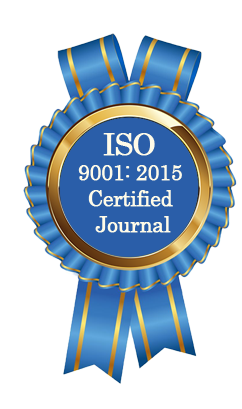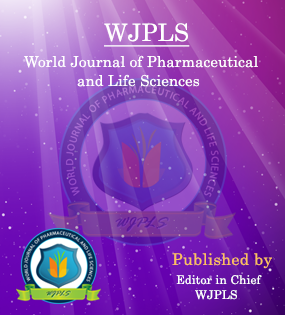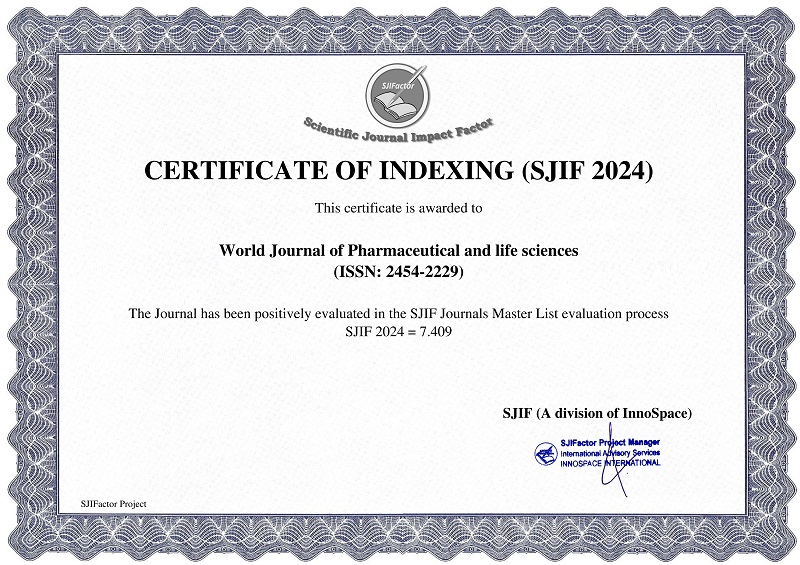Abstract
MOLECULAR AND BIOCHEMICAL ANALYSIS OF ANTIOXIDANT ENZYMES IN PULMONARY TISSUE OF RATS IN EXPERIMENTAL FLUOROSIS
Sukanya Thakur*, A. Shashi
ABSTRACT
Background: Fluoride toxicity is a global health problem with many countries have been declared endemic for fluorosis. Excessive accumulation of fluoride is manifested by skeletal fluorosis, dental fluorosis and various symptoms affecting non-skeletal tissues. The present study aimed to evaluate the toxicological effects of sodium fluoride (NaF) on biochemical and molecular gene expression levels of some antioxidant enzymes in the pulmonary tissue of fluoride-intoxicated rats. Methods: Wistar albino rats were randomly assigned to three groups. The control rats were given 1 ml deionized water orally for 40 days. Groups II and III were administered 300 and 600 mg NaF/kg b.w./day for the same period. Animals were sacrificed. The lung tissue was excised and used for biochemical and real-time PCR analysis. Results: The level of fluoride, malondialdehyde (MDA), reduced glutathione (GSH) and activities of different antioxidant enzymes such as cytosolic copper/zinc superoxide dismutase (Cu/Zn SOD), glutathione peroxidase (GPx) and catalase (CAT) were determined. The analysis of gene expression of different antioxidant enzymes in lung was done using Real-time PCR. The lung tissue exhibited significantly increased levels of fluoride and MDA (P<0.0001), while the GSH content decreased significantly (P<0.0001) in fluoridated rats. Additionally, the activities of antioxidant enzymes, including Cu/Zn SOD, GPx, and CAT, showed a significant decline (P<0.0001) compared to the control group. Pearson’s bivariate correlation and simple linear regression analysis revealed a strong positive correlation between lung tissue fluoride and MDA (r=0.993), while negative correlations were observed in GSH (r=-0.956) as well as in the activities of Cu/Zn SOD (r=-0.996), GPx (r=-0.994), and CAT (r=-0.982). The gene expression of Cu/Zn SOD, GPx and CAT was significantly (P<0.0001) reduced in fluorotic rats (P<0.0001). Conclusion: It is concluded that fluoride intoxication induces significant oxidative stress disrupting cellular metabolism and comprising the function of free radical scavengers. The increased lipid peroxidation and the decreased expression of antioxidant genes observed in the pulmonary tissue helps to depict the molecular mechanisms underlying the fluoride induced toxicity.
[Full Text Article] [Download Certificate]WJPLS CITATION 
| All | Since 2020 | |
| Citation | 590 | 424 |
| h-index | 12 | 10 |
| i10-index | 17 | 14 |
INDEXING
NEWS & UPDATION
BEST ARTICLE AWARDS
World Journal of Pharmaceutical and life sciences is giving Best Article Award in every Issue for Best Article and Issue Certificate of Appreciation to the Authors to promote research activity of scholar.
Best Article of current issue
Download Article : Click here





